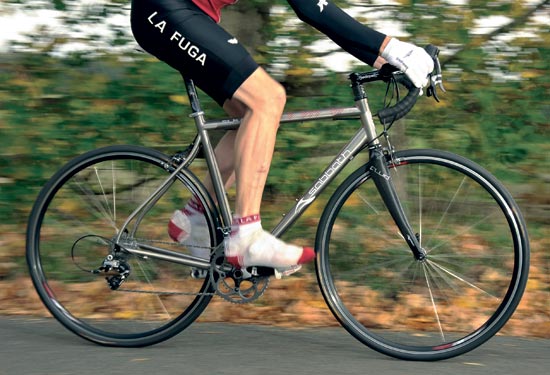Sabbath Silk Road Alp review

Sure, it's not the 'slab of rock' response of the best carbon but then on the way down the other side you do get the characteristic plush forgiveness of real metal over imperfect paving. And let's not forget that titanium also has a reputation for longevity. There was absolutely nothing we could criticise in the componentry, with exactly the package of parts that we would have hoped for. Well, for £3,000, we would have hoped for a more apparently ‘aero’ pair of wheels with deeper rims for the authentic racey look, but within this budget they would probably add weight while losing marginal drag, so it’s swings and roundabouts. In our opinion, Sabbath was wise to err on the side of nimbleness and we’re confident your bike shop would fit whatever wheels you preferred if it was a deal-breaker. We like SRAM components, especially this Rival group, perfect for the bike’s sportive aspirations. With the opposing camps of Shimano vs Campagnolo battling out their prejudices, we think the SRAM ‘double tap’ shifters are an ideal compromise between the silky smoothness and perfect ergonomics of Shimano’s STI shifters and Campagnolo’s positive and firm Ergopower levers, but we’ll probably never resolve that particular battle. Especially as there is such a choice of price levels and the three rivals keep refining the details; it’s what keeps trying different bicycles so interesting. £2,999 as shown here, £1,499 frameset only
-
+
Quality frame
-
+
Good ride characteristics
-
+
Light
-
+
Strong
-
-
Very little
You can trust Cycling Weekly.
The original Silk Road at £1,099 is titanium-only Sabbath's best-selling frame, and aimed fair and square at the burgeoning sportive market where riders are looking for the lightness and responsiveness of a full-on racing frame but with the reach and height of the handlebars a touch more comfortably positioned.
The new Silk Road Alp is a lighter variant on that theme, costing £400 more but weighing 200g less.
Niche player Sabbath has opted to keep the distinction between its sportive and race models subtle. A medium Silk Road Pro has a 12.5cm head tube whereas our Alp is 15cm with a 55cm top tube.
There's no doubt that paring 200g off the weight of the 1.5kg Silk Road by employing double-butted main tubes and thinner-walled seatstays was largely motivated by carbon frame competition, but it's welcome all the same.
Do the thinner tube walls result in the noodly feel that titanium frames have been criticised for?
It didn't take long to realise that this concern is unfounded. Maybe Jens Voigt expending 500 watts through his chainstays would be better qualified to nit-pick here but the kind of cheeky little bumps that tempt you to forego a downshift, necessitating a jump out of the saddle and a burst of effort, result in a satisfactory willingness to work very much with you.
The latest race content, interviews, features, reviews and expert buying guides, direct to your inbox!
Founded in 1891, Cycling Weekly and its team of expert journalists brings cyclists in-depth reviews, extensive coverage of both professional and domestic racing, as well as fitness advice and 'brew a cuppa and put your feet up' features. Cycling Weekly serves its audience across a range of platforms, from good old-fashioned print to online journalism, and video.